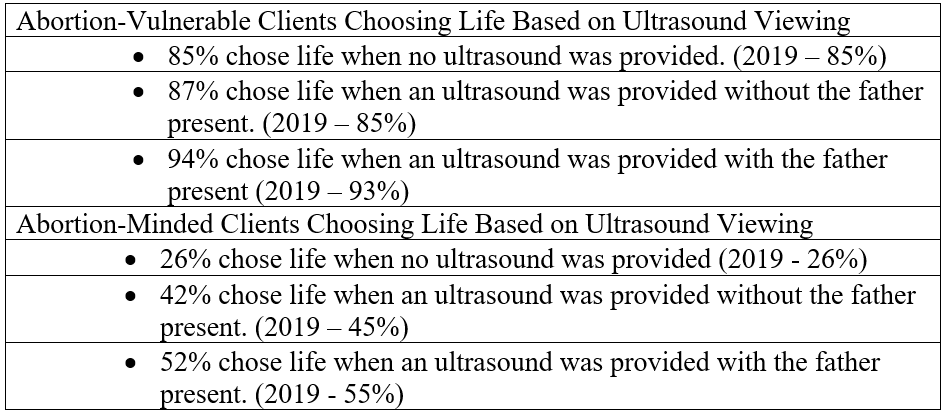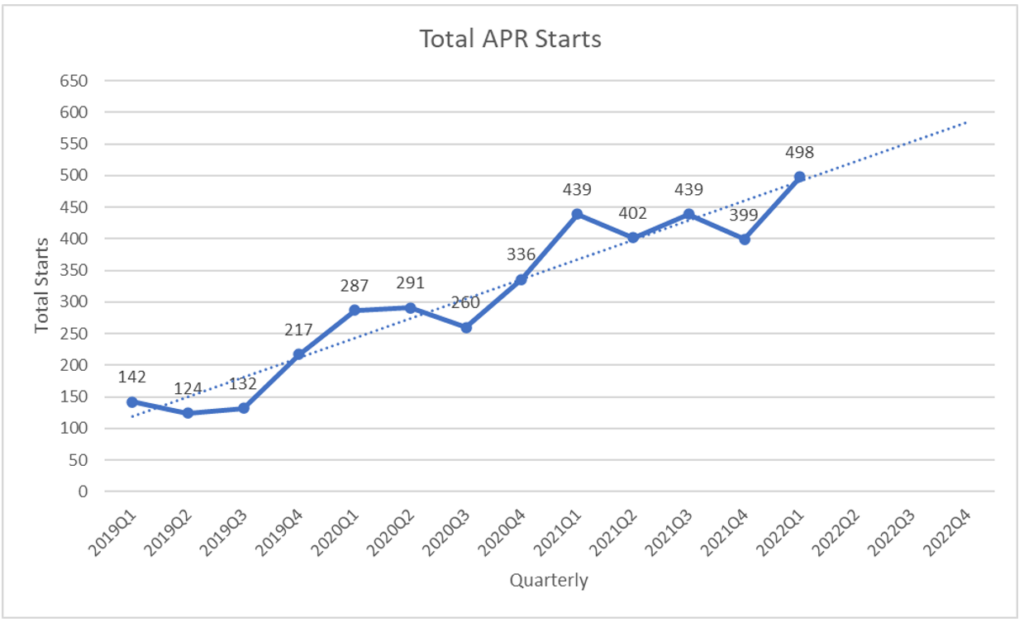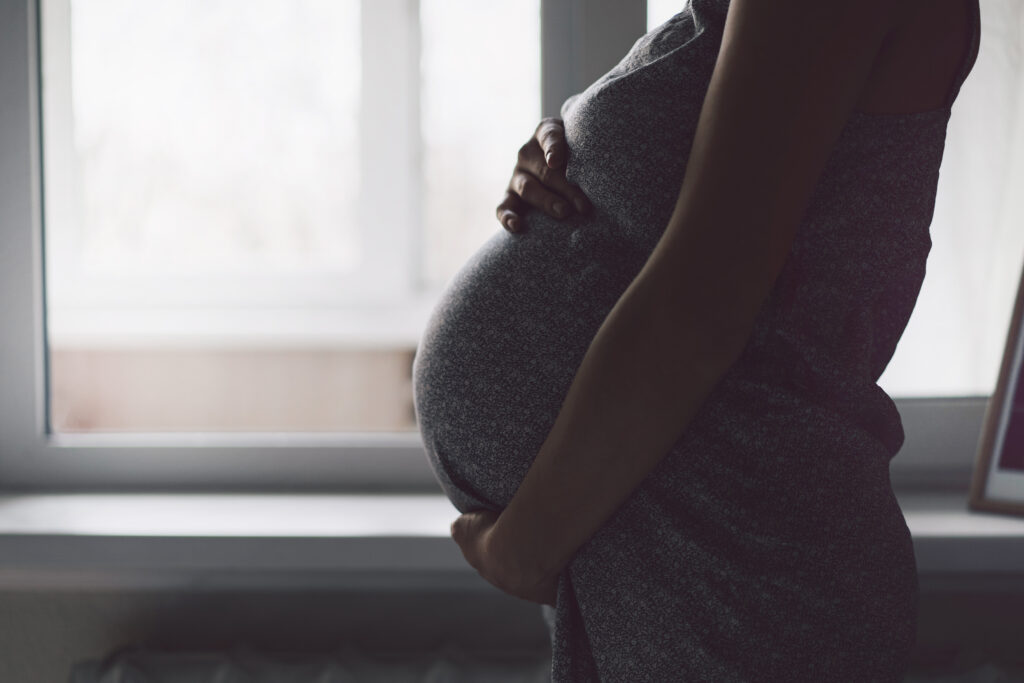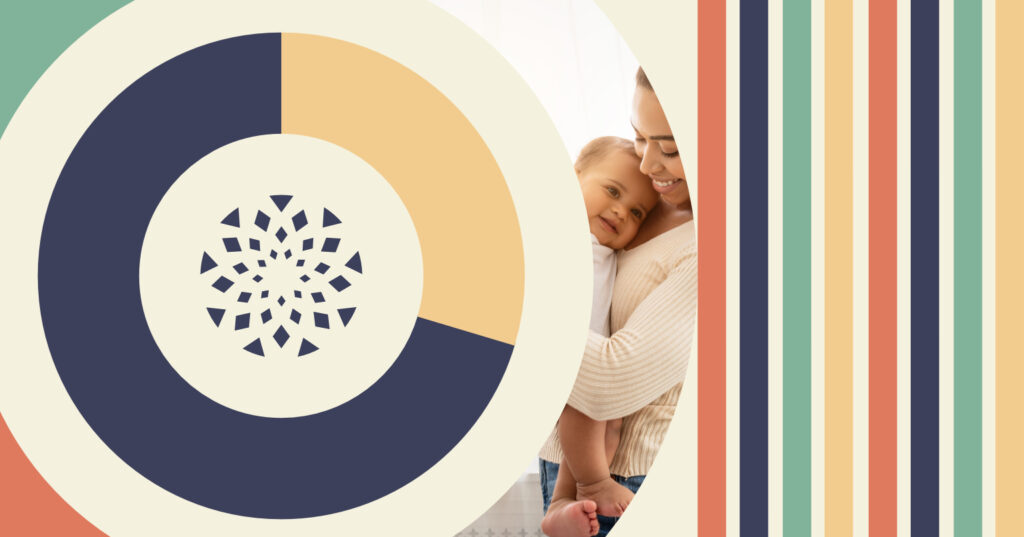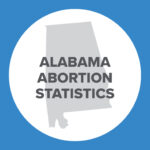Lives Saved Impact at U.S. Pregnancy Help Centers

This is Issue 83 in the On Point Series.
Life-affirming pregnancy help centers (PHCs) (also known as pregnancy resource centers, pregnancy care centers, or pregnancy centers) exist to provide support, education, classes, medical care and critical resources for women faced with difficult circumstances surrounding unexpected pregnancy.[1] The information provided to women deciding about a pregnancy spans pregnancy education, fetal development to detail the life developing in her, her options, and valuable help available to her. Over 5 years from 2016-2020, the result of the dedicated, compassionate care in U.S. PHCs is an estimated 828,131 Lives Saved, and millions of lives saved since the creation of PHCs over a half-century ago.
PHCs first organized in America at the community level in the late 1960s as abortion became legal in individual states.[2] Over 50 years since the first PHC opened its doors in 1969, approximately 3,000 PHCs across the country are serving mothers and families as well as women, men, and youth with a multitude of expanded services.[3]
Their aim is to provide women with holistic care – emotional, physical, relational, material, practical, and spiritual – and broad-ranging resources as well as support referrals typically at no or very low cost, all to enable women to both give birth to their children and pursue their life goals, rather than to see their children’s lives abruptly ended by abortion.
As reported by the Guttmacher Institute, recent trends reflect that unintended pregnancy in the U.S. decreased by 23 percent between 2015 and 2019. During this time period fewer unintended pregnancies ended in abortion, falling from 50 percent to 34 percent.[4] The abortion rate overall in the U.S. reached its lowest point since Roe v. Wade in 2017 at 13.5 abortions per 1,000 women aged 15-44 (the year abortion became legal nationally in 1973, the rate was 16.3).[5] In addition, for the first time, medication or chemical abortion (the “abortion pill”) now accounts for more than half (54 percent) of all U.S. abortions, which has led to a slight increase in abortion rates the past few years.[6],[7]
To advance the false narrative that abortion-on-demand is necessary in the United States, the openly pro-abortion organization, the Guttmacher Institute (GI), identified eight perceived reasons why women have abortions. We summarize six main reasons:
- Interference with school or career, and unreadiness for a child or another child.
- Financial difficulties.
- Single motherhood and relationship problems.
- Completed childbearing and responsibility to dependents.
- Fetal and personal health.
- [Negative] Opinions on adoption[8]
The well-documented work of PHCs supports women struggling with each of these perceived reasons for abortion, contributing to choices that are healthier, more informed, and more genuine to a woman’s true desired outcome.
Real-life stories from the millions of women and families who have been helped by PHCs counter the false narrative that women who faced unwelcomed pregnancies and choose life for their child are subjected to a life of diminished well-being, limited potential, and poverty. Approximately 3,000 PHCs form the foundation for a network of pregnancy help including adoption agencies, maternity housing, Alternatives to Abortion state funding programs, newer state-level initiatives like Her PLAN (Pregnancy and Life Assistance Network)[9], and more. Provided with access to care, tangible resources, information, advocacy, and targeted referrals, countless mothers have shared their stories about how they are very thankful they decided to have their babies and are flourishing even through the most difficult circumstances. These mothers are grateful for making a choice which saved a life and for visiting a PHC which showed them that it was possible and they were equipped to make that choice with supportive people who walk alongside them.
PHC impact has been quantified and documented since 2009 through aggregated national service provision and client totals as well as estimated value of services.[10] A summary of the most recent of these national figures and findings can be reviewed in the next section of this paper. What has not been as widely reported on is the number of “Lives Saved” due to PHCs.
Lives Saved is another important metric tracked at PHCs which demonstrates the number of at-risk for abortion women PHCs are reaching with life-affirming information and alternatives to abortion. The Lives Saved measurement is specifically defined as the total number of pregnant women assessed as being at-risk for abortion who choose to carry and give birth to their child (or children, in the case of twins and multiples, whereby several lives are counted) after visiting a PHC.
This paper examines a nationally representative subset of Lives Saved data through PHCs over the past five years. These data points reflect the vast numbers of women and their unborn children being reached by PHCs annually. They are of invaluable worth measuring the very gift of lives preserved.
In addition, recently reported data measuring Lives Saved through the intervention of Abortion Pill Reversal (APR) and a historical study examining the impact of ultrasound viewing in the PHC setting will be presented to show services delivered to women through life-affirming healthcare professionals at/involved through PHCs. These centers are effectively meeting women’s needs with excellent medical care.
Review of Recent National Findings on Pregnancy Help Center Service Provision
Aggregated service totals, people (women, men, youth) served, material items provided, estimated value of services, client satisfaction measures, and standards adhered to were last reported at the national level for PHCs in 2020.
In 2020 the Charlotte Lozier Institute in consultation with three national pregnancy center networks – Care Net, Heartbeat International, and the National Institute of Family and Life Advocates, or NIFLA – conducted a study of 2,700 PHCs which yielded the following results for the previous year.[11]
In 2019, 2,700 PHCs in the U.S. served roughly two million women, men, and youth with services estimated at a value of over $266 million. This outreach was accomplished through 14,977 total staff and 53,855 total volunteers, of which over 10,200 were licensed medical professionals (3,791 as staff and 6,424 as volunteers).[12]
Medical services were provided by an increasing number of centers since last counted in 2017[13] with: free obstetrical ultrasound services provided at 2,132 centers (79 percent), STD/STI Testing provided at 810 centers (30 percent), and STD/STI Treatment provided at 563 centers (21 percent).[14] In addition, 486,213 pregnancy confirmation ultrasounds, 731,884 pregnancy tests, 160,201 STI tests, and 967,251 consultations with new (unique) clients were all provided at little or no cost.[15]
PHCs were shown to be rich resources for support and education to improve maternal, child, youth and family health all at no cost, including: Prenatal and Parenting Classes at 2,312 centers (86 percent), Childbirth Classes at 742 centers (27 percent), Breastfeeding Consultations at 518 centers (19 percent), After-Abortion Support and Recovery at 1,931 centers (72 percent), Fertility Awareness-Based Methods at 188 centers (7 percent), Sexual Risk Avoidance Education Presentations to youth through 979 centers (36 percent).
PHCs also widely provided Material Item Services at 2,525 centers (94 percent). These items included: 1,290,079 packs of diapers, 689,382 packs of wipes, 30,445 new car seats, 2,033,513 baby clothing outfits, and 19,249 strollers.
In addition to care and material services, national PHC networks reported high client satisfaction (99 percent, on average per center) levels obtained through client exit surveys in 2019.[16]
PHCs adhere to ethical guidelines and standards set forth by national network organizations and adopted broadly by PHC member groups and affiliates. These standards are reflected in an updated 2019 version of “Our Commitment of Care and Competence.”[17]
This and prior national reports did not study Lives Saved from abortion through the national sample of PHCs. It is a data point of invaluable worth measuring the number of babies whose lives were protected by their mothers making courageous decisions for life. PHCs see and serve many women whose decisions for life have not definitively been made when they approach the center, and this aspect of the PHC mission is of the highest importance.
At-Risk for Abortion Assessment Framework and Lives Saved Impact
Assessment for what unique information, resources and referrals would benefit each woman visiting has been a core PHC client service for over five decades. Client advocates who meet one-on-one with women and couples listen for specific needs to make the appropriate referrals to care either within the PHC or in the local community.
In the early 2000s, when increased numbers of PHCs were beginning to provide medical services, a risk assessment framework with several categories for abortion vulnerability was largely adopted by PHCs for evaluation purposes.[18] This framework included criteria for identifying women visiting PHCs as Abortion-Vulnerable (AV) or Abortion-Minded (AM), or as Likely to Carry. Following several iterations, standardized guidance on definitions has been made widely available to PHCs.[19] The AV and the AM categories together constitute “at-risk for abortion” clients/patients. Individual PHCs track at-risk for abortion clients’ intentions to evaluate for Lives Saved from abortion.
Training for conducting at-risk for abortion assessment in PHCs typically includes published guidance and worksheets with ongoing monitoring and review.[20] Client advocates and medical workers who meet with women utilize checklist criteria forms to be completed for each client/patient to reduce bias and to ensure uniform implementation.
Abortion-Vulnerable (AV) criteria include: she has not eliminated the possibility of abortion; she lacks support from significant influencers; and she is undecided about her pregnancy.[21]
Abortion-Minded (AM) criteria include: she is seeking information on how to obtain an abortion; she has an abortion scheduled; and an abortion procedure has been initiated (such as the introduction of laminaria, or ingestion of the first pill, Mifeprex, in chemical abortion).[22]
Likely to Carry criteria include: she has stated that she has made a decision to carry to term; all indications reveal a healthy pregnancy; and she has support from all significant influences in her life.[23]
The Lives Saved measurement has been meticulously tracked by the national pregnancy center network Care Net since 2008 and Focus on the Family’s Option Ultrasound Program since 2004 in two separate de-identified datasets.
Care Net Nationally Representative Dataset
A nationally representative de-identified dataset measuring Lives Saved has been consistently collected and recorded annually since 2008. Care Net, a national pregnancy center network of over 1,200 affiliated pregnancy centers, requires completion of a broad services and operations data collection questionnaire as a condition for affiliate renewal each year. Care Net affiliated center staff are trained for consistency and accuracy towards this evaluation method for reliability of data reporting.[24]
While the PHCs represented in this dataset are affiliated with Care Net, a sizable number typically hold dual and even triple affiliation with the other national PHC networks Heartbeat International and NIFLA making it a nationally representative group of centers. For example, in 2021, nearly 400 PHCs were affiliated with all three national networks.[25] The Care Net affiliated PHCs represented in the Lives Saved analysis are a mix of medical pregnancy centers providing ultrasound services and non-medical pregnancy centers which do not provide ultrasounds to women. Further, the percentage of Care Net affiliated centers providing ultrasound services tracks with the national percentage of centers providing ultrasound services in studies published by CLI.[26]
The number of Lives Saved each year from 2016 through 2020 is highlighted in Table 1, and total 354,320 Lives Saved for the five-year period.[27] This number represents 354,320 little boys and girls saved following their mothers (and sometimes fathers) visiting a PHC.
While centers do not record the births of every client’s/patient’s baby, the intention to carry the baby to term would have been recorded by PHCs for each woman’s last appointment at or contact with the center (for example, at appointments for subsequent class attendance, material service visits, during a follow-up phone call, or the ultrasound appointment itself).
Since Care Net began tracking this invaluable statistic in 2008, the network reports cumulatively 886,125 Lives Saved over the past 13 years at its U.S.-affiliated PHCs.[28] This number is fast approaching one million.
Table 1: Care Net PHCs Estimated Lives Saved, 2016-2020
 *Note: Includes Medical Mobile Units counted as separate PHC locations.
*Note: Includes Medical Mobile Units counted as separate PHC locations.
**Note: The coronavirus global pandemic and U.S. national lockdown with subsequent factors affected overall client numbers in 2020.
In addition, when the Lives Saved figures from the nationally representative group of Care Net pregnancy help centers are weighted for the universe of U.S. pregnancy center locations CLI studied during the 2016-2020 five-year time period (2,600 center locations for 2016, 2017, and 2018, and 2,700 center locations for 2019 and 2020[29]), the national estimate of Lives Saved is 828,131 (Table 2).[30] This figure reflects the tremendous and awe-inspiring collective work of life-affirming pregnancy help centers, both medical and non-medical, to empower women and couples to choose life for their children.
Clearly, millions of children’s lives have been spared from abortion in America by virtue of their mothers visiting and receiving support from pregnancy help centers over the past 52 years.
Table 2: U.S. PHCs Estimated Lives Saved, 2016-2020
 *Note: Includes Medical Mobile Units counted as separate PHC locations.
*Note: Includes Medical Mobile Units counted as separate PHC locations.
Care Net also collects additional data to examine the effect of ultrasound viewing on at-risk for abortion women (both Abortion-Vulnerable and Abortion-Minded clients/patients), as well as whether or not the father of the baby is present for the pregnancy confirmation ultrasound with the mother of the baby.
Overall, with respect to ultrasound viewing, Care Net reports through its most recent U.S statistical summary for 2020, 75 percent of women at-risk for abortion who viewed their ultrasound at a PHC made a decision for life for their child.[31] This figure was 73 percent for 2019 data the network collected.[32]
The results highlighted in Table 3 show that, when viewing an early ultrasound image of their child, considerably more Abortion-Minded women make a decision for life if they viewed their ultrasound than if they did not (42 versus 26 percent). And when both Abortion-Vulnerable and Abortion-Minded women view the ultrasound of their child with the father of the baby present, significantly increased decisions for life are made.
The increased choices for life when the father of the baby is present for an ultrasound in both groups of AV and AM PHC clients (Table 3) appear to suggest that ultrasound viewing is a significant event for men as well, at least in 2020 (and 2019). Care Net and LifeWay Research conducted and published two studies in 2015 and 2022 which both asked about the most influential people in women’s pregnancy decisions. In 2015, nearly 4 in 10 women stated that the most influential person in her pregnancy decision was the expectant dad, over medical professional (26 percent), mother (14 percent), and friend (8 percent).[33] In 2021, in the Care Net Study of American Men Whose Partner Has Had an Abortion, of 1,000 men retrospectively surveyed after their partner had an abortion in which they participated, 38 percent responded that he was the most influential person in her decision – over medical professional (18 percent), mom (14 percent), and friend (7 percent).[34] In circumstances where a woman shares there’s a positive relationship and she is interested, PHCs encourage the father of the baby to attend her ultrasound appointment as well as ongoing prenatal and parenting education classes at the center.
Table 3: Ultrasound Viewing Effect on Choosing Life, Care Net 2020 (and 2019) Data[35],[36]
National Institute of Family and Life Advocates (NIFLA) 2013 Study on Pregnancy Confirmation Ultrasound Viewing
The effectiveness of ultrasound confirmation of pregnancy viewing in the PHC setting was further studied in 2013 by the national network NIFLA. NIFLA is a national pregnancy center network of now 1,600 affiliates, the vast majority of which are medical pregnancy centers and clinics. NIFLA provides legal and medical expertise and guidance to PHCs and has guided over 1,400 PHCs through medical clinic compliance and conversion.
The 2013 survey included two questions for which NIFLA published the results. The first question asked affiliates, “In 2013, how many ultrasound confirmations of pregnancy did you provide to mothers at-risk for abortion?” (“At-risk for abortion” was described in detail and aligned with the definitions listed above.)
The results from the 406 medical PHC affiliates that responded showed that 74,009 ultrasound confirmations were provided in 2013. Of those, 57,599 or 78 percent indicated that they were going to carry their pregnancy to term. The network stated, “Thus, 78 percent of such [at-risk for abortion] mothers who viewed their children via ultrasound chose life.”[37]
The second survey question asked whether “Ultrasound confirmation of pregnancy had a positive impact on the decisions of mother at-risk for abortion to choose to carry their pregnancies to term.” The responses were as follows from the 406 respondents.
- Absolutely – 339 (83.5 percent)
- More than likely – 64 (15.76 percent)
- Only a small impact – 3 (0.74 percent)
- No impact at all – 0[38]
The results further speak to the impact ultrasound viewing has as medical information through technical sonographic imaging is delivered to women. Pregnancy confirmation ultrasound is provided free of charge to women by PHCs thereby increasing access to care as well as medical knowledge for themselves, and in some cases for expectant dads, about their developing babies.
Focus on the Family Option Ultrasound Program Lives Saved at Medical PHCs
The estimated Lives Saved statistic has also been tracked by Focus on the Family’s Option Ultrasound Program (OUP) since the program’s inception in 2004. OUP provides grants to PHCs for ultrasound machines, sonography training, medical conversion through The Life Choice Project offered in conjunction with NIFLA, and digital marketing. Between 2004 and 2008, the group placed 400 ultrasound machines in PHCs. Since 2004, OUP has awarded well over 1,000 grants to qualifying PHCs.
Careful and consistent tracking of data is a condition of OUP grants. Published instructions and accompanying guidance related to at-risk for abortion assessment are given to grantees to enhance evaluation practices and increase the reliability of tracked data. OUP requires that their grantees track and report back two specific de-identified data points: the number of at-risk for abortion clients who receive an ultrasound and each client’s decision whether to carry their unborn child to term.
From program launch in 2004 through the end of 2021, Focus on the Family’s OUP cites 481,738 “estimated babies saved” at medical PHCs providing ultrasound services that have received their grants.[39]
The results concerning ultrasound viewing choices for life, and estimated Lives Saved reported by Care Net, NIFLA and Focus on the Family’s Option Ultrasound Program, suggest that ultrasound viewing has a dramatic impact on the decisions of women who are vulnerable to abortion. These results also provide strong credibility and legitimacy for the gold standard medical technology of ultrasound as a way to communicate medically accurate and visually (and audibly) important information (for example, a heartbeat) about the life developing inside of a pregnant woman.
Note: As discussed above, recent national findings show that 79 percent or 8 out of 10 PHCs studied provide pregnancy confirmation ultrasounds (limited obstetrical ultrasounds) by licensed healthcare professionals, free of charge to patients. Centers offering medical services including ultrasounds are required to operate under the supervision of a licensed physician in accordance with guidelines national network affiliates must adhere to.[40]
As a gold standard in obstetrical care for more than five decades, PHCs perform limited obstetrical ultrasounds for three reasons: (1) to confirm if a pregnancy is in a woman’s uterus; (2) to confirm if the baby has cardiac activity – a heartbeat; and (3) to provide an estimate of gestational age. Not all medical PHCs provide gestational age estimates.[41]
Lives Saved Through Abortion Pill Reversal (APR)
Another area where lives are saved through PHC involvement is the medically administered intervention of Abortion Pill Reversal (APR). A woman who has already begun a chemical abortion by taking the “abortion pill” and then seeks to stop the abortion may receive help from a PHC directing her where to find professional assistance with APR.
The “abortion pill,” originally known as RU-486, is a regimen requiring the two-drug combination of mifepristone and misoprostol, both taken orally up to 10 weeks pregnancy/last menstrual period.[42] Since first being introduced into the U.S. market in 2000, usage of the abortion pill has steadily increased, accounting for nearly 40 percent of all abortions in the U.S. in 2017.[43] According to preliminary findings reported by the Guttmacher Institute, in 2020 for the first time, chemical abortion – or the abortion pill – now accounts for more than half (54 percent) of all U.S. abortions.[44]
The abortion pill reversal (APR) medical protocol was developed by two physicians, Dr. Matthew Harrison and Dr. George Delgado, in 2007. The two physicians applied the premise that progesterone had been administered safely for four decades to maintain pregnancy in early miscarriage due to low progesterone levels. Progesterone, naturally produced by women in higher levels during pregnancy, functions to prepare the endometrium, develop the placenta, inhibit contractions and keep the cervix closed. In the case of the abortion pill regimen, the progesterone therapeutically counteracts the progesterone-blocking action of mifepristone – the first drug taken. In 2007, the first recorded saving of a baby occurred when Dr. Harrison administered the progesterone protocol to a woman who had taken mifepristone to terminate her pregnancy and sought to stop it. In collaboration with another physician-researcher, Dr. Mary Davenport, the three physicians founded Abortion Pill Reversal Network under Culture of Life, San Diego, California in 2012 as a 24/7 live referral network, hotline, and website to link women to time-sensitive care.
In 2018, the network and hotline fully shifted to be housed under the international pregnancy center network Heartbeat International with 3,030 pregnancy help organization affiliates (including life-affirming maternity homes and adoption providers) in 79 countries and two territories worldwide.[45] The network was renamed as Abortion Pill Rescue Network (APRN).
The APRN reports that in two of every three instances, women who initiate the protocol within the recommended timeframe save the lives of their babies. The process begins with the administration of progesterone to reverse the effects of the abortion pill. An ultrasound is then performed to determine if the baby has cardiac activity (a heartbeat) indicating viability of the baby. If viable, progesterone is administered for another two-week minimum. Women are then referred to local PHCs for continued support and resources.
The largest peer-reviewed study to date indicates that the success rate of the APR protocol if initiated within 72 hours after use of the first drug mifepristone is as follows: 68 percent reversal rate for the oral protocol and 64 percent reversal for injection protocols.[46] (Importantly, the abortion pill regimen of mifepristone and misoprostol has been studied and shown not to increase risk of either preterm birth or birth defects in live-born infants who survive despite the abortion attempt and APR process.[47])
In addition, PHCs are fulfilling a central role in first communicating accurate information to women across the country about the existence of this life-saving protocol which provides tangible hope if a woman regrets starting the chemical abortion process. Second, PHCs are providing linkages to care by either providing women with information about the number to call the Abortion Pill Rescue Network to initiate the process and/or directing them to a licensed provider in the area who can facilitate the care. Heartbeat International’s 24/7 Option Line bridges callers to APR-trained and licensed nurses who direct and facilitate critically time-sensitive connections to care.
The expansion of professional-level care providers in APRN and the study findings compiled over the past five years are impressive (Table 4). Currently, the network reports that over 3,000 babies’ lives have been saved worldwide through the Abortion Pill Reversal protocol since Culture of Life began tracking and recording the babies born following the APR protocol in 2012.[48] The figure of over 1,000 Lives Saved was reached by the end of 2019.
The number of healthcare professionals providing the life-saving protocol of APR to women in the U.S and around the world is increasing every year. The number has risen from over 400 in 2017 worldwide to over 1,100 healthcare professionals worldwide by 2022.
Table 4. Abortion Pill Rescue Network Statistics*
 *Note: Totals are estimates based on current Heartbeat International data collected.
*Note: Totals are estimates based on current Heartbeat International data collected.
The recorded number of “reversal starts” through APR reflects a steady increase from 2019 through March 2022[49] (Fig. 1). Over the past almost 3.5 year period, reversal starts have increased by 327 percent. (Note: A reversal start occurs “when a woman receives a referral to an APR provider, the provider determines that she is a candidate for abortion pill reversal, and she has received a prescription for treatment. If APRN later learns that she ultimately did not start treatment, her case is no longer considered a reversal start.”[50])
In addition, APRN reports that an average of 150 women started the reversal process each month in both 2019 and 2020, and an average of “150 plus” women per month started reversals in 2021.[51] In addition, women in all 50 states contacted APRN each year 2019-2021, which means knowledge of the APR protocol is being widely disseminated nationwide.[52]
While this number of 3,000 Lives Saved by APR itself demonstrates phenomenal impact, the real-life stories and photos highlighted on APRN’s website make these outcomes vivid and personal.[53] These real-life stories have been collected since 2012 and are indisputable evidence of the effectiveness of the APR protocol, validating these intervention services.
As the abortion pill is an increasingly chosen abortion method, access to APR will be evermore essential. Medical PHCs will be increasingly utilized to provide ultrasounds and ongoing supports to mothers seeking the life-saving intervention. APRN hotline nurses will provide medical guidance to a woman’s own licensed medical caregiver if a professional in their network is not located within traveling distance to a woman.
Figure 1. Reversal Starts through Abortion Pill Rescue Network
The Lives Saved from APR to date are a testimony to the sheer will of medical professionals involved in the pro-life movement to help bring health and healing following the introduction of the abortion pill.
PHCs and Beyond as a System of Care for Women
While the nation’s nearly 3,000 PHCs provide vast and valuable services to families facing unintended pregnancies, more support will be needed in a post-Roe America to complement their work.
Such support is already springing up in new initiatives seeking to connect PHCs with other life-affirming assistance providers to offer women services beyond what PHCs can provide in caring for pregnant and parenting women.
One such endeavor, Her PLAN (Her Pregnancy and Life Assistance Network) connects providers across seven categories of care that experts have identified as critical to empower women to carry pregnancies to term and care for their families beyond. These categories of care include Mentorship, Health and Well-being, Financial Assistance with Education or Career/Job Assistance, Material or Legal Support, Recovery and Mental Health, Prenatal Diagnosis, and Care for Children.[54]
Within the seven categories of care are 25 sub-categories that offer specific services, including, but not limited to: comprehensive prenatal care, pediatric care, job skills training, parenting education, legal help, housing, licensed professional counselors, domestic violence shelters, disability support organizations, childcare, and adoption services.
Currently, Her PLAN is active in four (4) states, with plans to expand to 30 by the end of 2024. Her PLAN’s online directory is HIPAA- and ADA- compliant and user-friendly.[55]
State and local governments have also offered support to PHCs and women facing unintended pregnancies. Currently, 14 states authorize some form of alternatives to abortion (A2A) funding to life-affirming Pregnancy Help Organizations (PHOs), which typically include pregnancy centers, adoption agencies, maternity homes and life-affirming social service agencies. These states include Florida, Georgia, Indiana, Kansas, Louisiana, Minnesota, Missouri, North Carolina, North Dakota, Ohio, Oklahoma, Pennsylvania, Texas, and Wisconsin. Collectively, these states have appropriated approximately $94 million[56] annually to assist PHCs, maternity homes, adoption agencies, and life-affirming social service agencies. This funding has helped PHCs expand their services to support their communities. Some have added needed medical services; others have expanded material goods distribution, parenting education, and other services.
In addition to supporting PHCs financially, at least 20 states have honored PHCs with resolutions affirming the value PHCs bring to their communities. While these resolutions vary by state, most acknowledge that “the life-affirming impact of pregnancy resource centers and maternity homes on women, families, and the communities they serve is considerable and growing, and pregnancy resource centers and maternity homes serve with integrity and compassion”[57] (emphasis added).
The Federal government has also funded many PHCs through grant programs, such as Sexual Risk Avoidance Education (SRAE) grants, Maternity Group Home grants, and even Title X grants. In FY20, the federal government directly funded eight (8) PHCs, through two grants for Sexual Risk Avoidance Education, totaling approximately $3 million.[58]
Public support for and interest in maternity homes has increased substantially since the first maternity home was opened in 1886.[59] In the 1970s, Jim and Anne Pierson helped develop the modern model for maternity homes and opened their first maternity home in Lancaster, Pennsylvania.[60] By 1984, the Piersons expanded their outreach and started Loving and Caring, Inc., a life-affirming nonprofit that provides “materials and services to agencies and Christian ministries which serve teen moms, single parents, and families affected by crisis pregnancy.” Their outreach covers over 5,000 ministries, organizations, and individuals. During this time, President Ronald Reagan praised the efforts of Loving and Caring in a speech, bringing more recognition to the evolving maternity home movement.[61] It is currently estimated that there are some 400 maternity housing locations throughout the United States, serving approximately 1,800 adult women,[62] and the federal government currently funds a maternity group home program through the U.S. Department of Health and Human Resources Family and Youth Services Bureau.[63] Public support for adoption is also increasing, particularly foster care adoptions, which increased 12% from 2011 to 2020.[64]
Finally, organizations such as Care Net have made strides in equipping churches to become more proactively involved in serving women and men at-risk for abortion. Through its Making Life Disciples program, “Care Net is working to equip the Church to lead with credibility and love – offering compassion, hope, help, and discipleship to women and men facing pregnancy decisions knowing that those considering abortion need access to long term care that the Church is designed to provide.”[65]
Conclusion
Pregnancy help centers are making a difference in the lives of American women and families. Their impact is clear through both service provision with needed support, classes, medical care, resources, and the Lives that have been Saved.
There have been an estimated 828,131 Lives Saved when women at-risk for abortion visited and received support from PHCs during 2016-2020. If all PHCs in America reported decisions for life over the course of the 52 years they have now been in existence, it is easily inferred that millions of lives have been spared from abortion as a result of PHC care and services provided to women and families.
Medical professionals and workers at these PHC locations are readying to meet the increased needs in a post-Roe America to help embrace a culture of Life.
An abortion-friendly organization, the Guttmacher Institute, indicates that 26 states are currently poised to significantly restrict abortion if the leaked Supreme Court opinion stands and Roe is reversed.[66] In light of this, a main goal of the pro-life movement is to support PHCs and other pregnancy help organizations to create a wide and “ever-growing pro-life safety net.”[67]
More than any other organization, pro-life PHCs are best equipped to support women facing unintended pregnancies in a post-Roe America. The proven number of “Lives Saved,” detailed in this paper, demonstrates the truth that author and pro-life convert Frederica Mathewes-Green observed, “No one wants an abortion as she wants an ice-cream cone or a Porsche. She wants an abortion as an animal, caught in a trap, wants to gnaw off its own leg.”[68] By offering basic support and pregnancy information, PHCs empower women to avoid such cruel dilemmas and instead make informed and healthy choices to carry children to term.
Moira Gaul, M.P.H. is an associate scholar with the Charlotte Lozier Institute where she works on pregnancy center studies and women’s health-related issues. Jeanneane Maxon, J.D. is an associate scholar with the Charlotte Lozier Institute and non-profit law and compliance consultant serving clients including pro-life pregnancy centers.
[1] “Pregnancy Centers Stand the Test of Time.” A Legacy of Life and Love Report Series. Charlotte Lozier Institute 2020. Available at: Pregnancy-Center-Report-2020_FINAL.pdf (lozierinstitute.org) (Accessed 9 May 2022).
[2] “A Half Century of Hope, A Legacy of Life and Love.” Charlotte Lozier Institute. 2018. Available at: A-Half-Century-of-Hope-A-Legacy-of-Life-and-Love-FULL.pdf (pcdn.co) (Accessed 9 May 2022).
[3] Gaul, M. “Fact Sheet: Pregnancy Centers – Serving Women and Saving Lives (2020 Study).” Charlotte Lozier Institute. 2021. Available at: https://lozierinstitute.org/fact-sheet-pregnancy-centers-serving-women-and-saving-lives-2020/ (Accessed 9 May 2022).
[4] “Unintended Pregnancy and Abortion in North America.” Fact Sheet. Guttmacher Institute. 2022. Available at: unintended-pregnancy-and-abortion-northern-america.pdf (guttmacher.org) (Accessed 9 May 2022).
[5] “Induced Abortion in the United States.” Fact Sheet. Guttmacher Institute.2019. Available at: fb_induced_abortion.pdf (guttmacher.org) (Accessed 9 May 2022).
[6] Jones, R.K., Nash, E., Cross, L. et al. “Medication Abortion Now Accounts for More Than Half of All US Abortions.” Guttmacher Institute. February 2022. Available at: Medication Abortion Now Accounts for More Than Half of All US Abortions | Guttmacher Institute (Accessed 9 May 2022); “Fact Sheet: What the Guttmacher Institute’s Report on Chemical Abortion Doesn’t Say,” Charlotte Lozier Institute. Feb 2022. Available at: https://lozierinstitute.org/fact-sheet-what-the-guttmacher-institutes-report-on-chemical-abortion-doesnt-say/
[7] U.S. Abortion Trends: 2019 and Preliminary 2020 – Charlotte Lozier Institute
[8] Finer, L.B., et al. “Reasons U.S. Women Have Abortions: Quantitative and Qualitative Perspectives.” Perspectives on Sexual and Reproductive Health, 2005, 37(3):110–118. Available at: https://www.guttmacher.org/sites/default/files/article_files/3711005.pdf (Accessed 19 Nov. 2020).
[9] https://herplan.org/about/
[10] “A Passion to Serve, A Vision for Life.” Pregnancy Resource Service Report 2009. Family Research Council. 2009. Available at: EF09I51.pdf (frc.org) (Accessed 9 May 2022); “A Passion to Serve, How Pregnancy Resource Centers Empower Women, Help Families, and Strengthen Communities.” Pregnancy Resource Center Service Report, Second Edition. Family Research Council. 2011. Available at: EF12A47.pdf (frc.org) (Accessed 9 May 2022); “A Half Century of Hope, A Legacy of Life and Love.” Pregnancy Center Service Report, Third Edition. Charlotte Lozier Institute. 2018. Available at: A-Half-Century-of-Hope-A-Legacy-of-Life-and-Love-FULL.pdf (pcdn.co) (Accessed 9 May 2022). “Pregnancy Centers Stand the Test of Time.” A Legacy of Life and Love Report Series. Charlotte Lozier Institute 2020. Available at: Pregnancy-Center-Report-2020_FINAL.pdf (lozierinstitute.org) (Accessed 9 May 2022).
[11] “Pregnancy Centers Stand the Test of Time.” A Legacy of Life and Love Report Series. Charlotte Lozier Institute 2020. Available at: Pregnancy-Center-Report-2020_FINAL.pdf (lozierinstitute.org) (Accessed 9 May 2022).
[12] “Pregnancy Centers Stand the Test of Time.” Pg 17.
[13] “Pregnancy Centers Stand the Test of Time.” Updated 2017 results, pgs. 19 and 22.
[14] “Pregnancy Centers Stand the Test of Time.” Table 3, pg. 17.
[15] “Pregnancy Centers Stand the Test of Time.” pg. 16.
[16] “Pregnancy Centers Stand the Test of Time.” Pg. 66.
[17] “Pregnancy Centers Stand the Test of Time.” Pg. 63-66.
[18] “Turning Hearts Toward Life II.” Charlotte Lozier Institute. 2015.
[19] “Abortion Risk Assessment Framework.” Adopted by Leadership Alliance of Pregnancy Care Organizations (LAPCO). 2017. Emailed by Cindy Hopkins Oct 2020.
[20] “Initial Assessment of Client’s Abortion Vulnerability” Worksheet. Care Net. 2020. Email from Care Net staff C. Hopkins 10 Nov. 2020.
[21] “Abortion Risk Assessment Framework.” Adopted by Leadership Alliance of Pregnancy Care Organizations (LAPCO). 2017. Emailed by C. Hopkins 10 Nov. 2020.
[22] Ibid.
[23] Ibid.
[24] Human error in reporting is always possible to occur. Given the methods that have been in place since 2008 as well as annual monitoring by Care Net with follow-up training, errors in reporting are minimized.
[25] Analysis by M. Bean, CLI Associate Scholar, reviewing affiliation files for all three national PHC networks. Email 26 Aug. 2021.
[26] “Pregnancy Centers Stand the Test of Time.” Pgs. 17 and 22. “U.S. Care Net Statistical Report: 2019 Calendar Year Data.” Care Net. 2020.
[27] Care Net annual statistics compiled and sent by staff E. Gleason in an email 28 Feb. 2022 (4:38pm).
[28] “U.S. Care Net Statistical Report: 2020 Calendar Year Data.” Care Net. 2021.
[29] Charlotte Lozier Institute national pregnancy center reports studied 2,600 U.S. pregnancy centers in 2017, and 2,700 pregnancy centers in 2019. “Pregnancy Centers Stand the Test of Time.” Updated 2017 results, pgs. 19 and 22.
[30] Statistical weighting and calculations provided by Dr. M. New, CLI Associate Scholar.
[31] “U.S. Care Net Statistical Report: 2020 Calendar Year Data.” Care Net. 2021.
[32] “U.S. Care Net Statistical Report: 2019 Calendar Year Data.” Care Net. 2020.
[33] “Study of Women Who Have Had an Abortion and Views on Church.” LifeWay Research and CareNet. 2015. Available at: http://lifewayresearch.com/wp-content/uploads/2015/11/Care-Net-Final-Presentation-Report-Revised.pdf (Accessed 9 May 2022).
[34] “Care Net Study of American Men Whose Partner Has Had an Abortion.” LifeWay Research and Care Net. 2022. Pg 10. Available at: Care Net Study of Men and Abortion (care-net.org) (Accessed 9 May 2022).
[35] “U.S. Care Net Statistical Report: 2020 Calendar Year Data.” Care Net. 2021.Pg 10.
[36] “U.S. Care Net Statistical Report: 2019 Calendar Year Data.” Care Net. 2020.Pg 10.
[37] “Legal Tips, Clinic Tips.” Volume XXII Number 2. National Institute of Family and Life Advocates. February 2015.
[38] Ibid.
[39] Focus on the Family Option Ultrasound Program Lives Saved update. Email from program staff 24 February 2022.
[40] “Our Commitment of Care and Competence.” Updated 2019. Heartbeat International. Available at: https://www.heartbeatinternational.org/about/our-commitment. (Accessed 9 May 2022).
[41] “Pregnancy Centers Stand the Test of Time.” Pg. 32.
[42] Jones, R.K., Nash, E., Cross, L. et al. “Medication Abortion Now Accounts for More Than Half of All US Abortions.” Guttmacher Institute. February 2022. Available at: Medication Abortion Now Accounts for More Than Half of All US Abortions | Guttmacher Institute (Accessed 9 May 2022); “Fact Sheet: What the Guttmacher Institute’s Report on Chemical Abortion Doesn’t Say,” Charlotte Lozier Institute. Feb 2022. Available at: https://lozierinstitute.org/fact-sheet-what-the-guttmacher-institutes-report-on-chemical-abortion-doesnt-say/
[43] Ibid.
[44] Ibid.
[45] “Life Trends 2022 Report.” Presented by Heartbeat International. 2022. Available at: Life Trends (heartbeatinternational.org)
[46] Delgado, G., Condly, S., et al. “A Case Series Detailing the Successful Reversal of the Effects of Mifepristone Using Progesterone.” Issues in Law and Medicine Vol. 33, 1. 2018, Revisions 2019. Available at: Delgado-Revisions-FINAL-1.pdf (issuesinlawandmedicine.com) (Accessed May 2022).
[47] Davenport, M. et al. “Embryo Survival After Mifepristone: A Systematic Review of the Literature,” Issues in Law and Medicine Vol. 32, 1. 2017; Bernard, N., Elefant, E. et al. “Continuation of Pregnancy After First-Trimester Exposure to Mifepristone: An Observational Prospective Study.” BJOG Vol. 120, 5. 2013. (http://onlinelibrary.wiley.com/doi/10.1111/1471-0528.12147/epdf ) (Accessed 12 Aug 2020); Delgado, G. et al., “A Case Series Detailing the Successful Reversal of the Effects of Mifepristone Using Progesterone,” Issues in Law & Medicine Vol. 33, 1. 2018. Available at: Delgado-Revisions-FINAL-1.pdf (issuesinlawandmedicine.com) (Accessed May 2022).
[48] Abortion Pill Rescue Network, 2021 Impact Report. Heartbeat International.
[49] Graph provided by Abortion Pill Rescue Network in email from Heartbeat International staff member B. McDowell 10 June 2022.
[50] Ibid.
[51] APR 2020 Stats., Heartbeat International. Abortion Pill Rescue Network, 2021 Impact Report, Heartbeat International. Both reports received by email from Heartbeat International staff member B. McDowell 25 April 2022.
[52] Ibid.
[53] Abortion Pill Rescue Network Lives Saved. Available at: Abortion Pill Rescue Network Lives Saved (heartbeatinternational.org) Accessed 12 May 2022.
[55] https://directory.herplan.org/
[56] This figure is based on the allocation for each state’s most current fiscal year for which the data is reported. In some cases, where states approved budgets for multiple years, the average annual allocation was included.
[57] See Missouri HR No. 1826. 96th General Assembly. Available at: https://www.house.mo.gov/billtracking/bills111/biltxt/intro/HR1826I.htm. (Accessed 24 May 2022).
[58] See “General Departmental Sexual Risk Avoidance Education (GD SRAE) Grantees FY2020.” Family and Youth Services Bureau, Office of the Administration for Children and Families, U.S. Department of Health and Human Services. 12 Nov. 2020. Available at: https://www.acf.hhs.gov/fysb/general-departmental-sexual-risk-avoidance-education-srae-grantees-fy2020 (Accessed 25 May 2022). And See “Title V Competitive Sexual Risk Avoidance Education (SRAE) Grantees FY2020.” Family and Youth Services Bureau, Office of the Administration for Children and Families, U.S. Department of Health and Human Services. 15 Nov. 2020. Available at: https://www.acf.hhs.gov/fysb/title-v-competitive-sexual-risk-avoidance-education-srae-grantees-fy2020 (Accessed 25 May 2022).
[59] Mansnerus, Laura. “COMMUNITY; No Shame, but Plenty of Need, at Home for Unwed Mothers.” The New York Times. 15 Feb. 1998. Available at: https://www.nytimes.com/1998/02/15/nyregion/community-no-shame-but-plenty-of-need-at-home-for-unwed-mothers.html (Accessed 30 November 2018).
[60] Pierson, Anne, Director of Ministry Services, Loving and Caring. Personal Interview. 1 Jan. 2019.
[61] Ministry Overview. Loving and Caring. 2019. Available at: https://lovingandcaring.org/about-us/ministry-overview (Accessed 14 Jan. 2019).
[62] Peterson, Mary, Facilitator and Housing Specialist, National Maternity Housing Coalition. Email to Jeanneane Maxon. 3 Jan. 2019.
[63] “Maternity Group Home Program Fact Sheet.” Family and Youth Services Bureau, Administration for Children and Families, U.S. Department of Health and Human Services. September 2020. Available at: https://www.acf.hhs.gov/sites/default/files/documents/fysb/mgh_fact_sheet_september_2020.pdf (Accessed 24 May 2022).
[64] “Trends in Foster Care & Adoption: FY 2011- 2020.” Children’s Bureau, Administration for Children and Families, U.S. Department of Health and Human Services. 30 Nov. 2021. Available at: https://www.acf.hhs.gov/cb/report/trends-foster-care-adoption (Accessed 24 May 2022).
[65] Making Life Disciples program description provided by Care Net staff E. Forsythe in email 16 June 2022. (1:03pm)
[66]Nash, E. & Cross, L. “26 States Are Certain or Likely to Ban Abortion Without Roe: Here’s Which Ones and Why.” Guttmacher Institute. Updated 19 April 2022. Available at: https://www.guttmacher.org/article/2021/10/26-states-are-certain-or-likely-ban-abortion-without-roe-heres-which-ones-and-why (Accessed 10 May 2022).
[67]Dannenfelser, M. & Donovan, C. “The road beyond Roe for the pro-life movement.” The Washington Post. 13 May 2022. Available at: https://www.washingtonpost.com/opinions/2022/05/13/after-roe-pro-life-anti-abortion-movement-road-ahead/ (Accessed 10 May 2022).
[68] Mathewes-Green, F. “Seeking Abortion’s Middle Ground.” The Washington Post. 28 July 1996. Available at: https://www.washingtonpost.com/archive/opinions/1996/07/28/seeking-abortions-middle-ground/f04dd815-967d-4dbe-a28f-6e1b73ea6d1f/ (Accessed 16 Nov. 2020).












